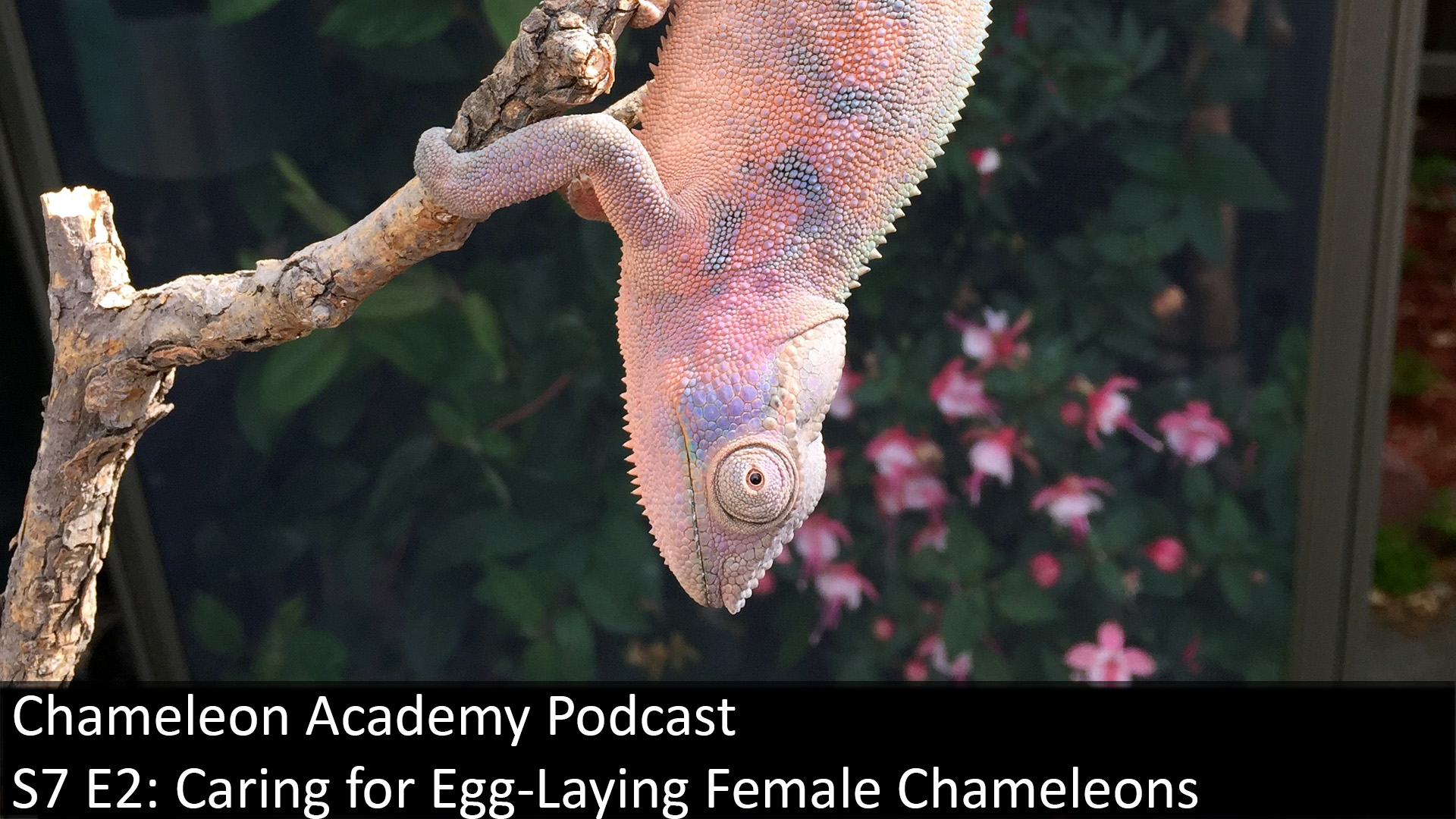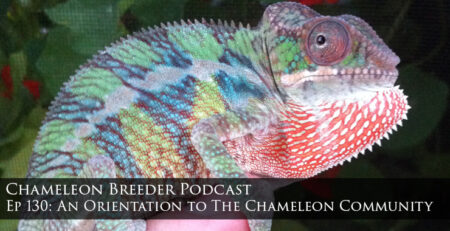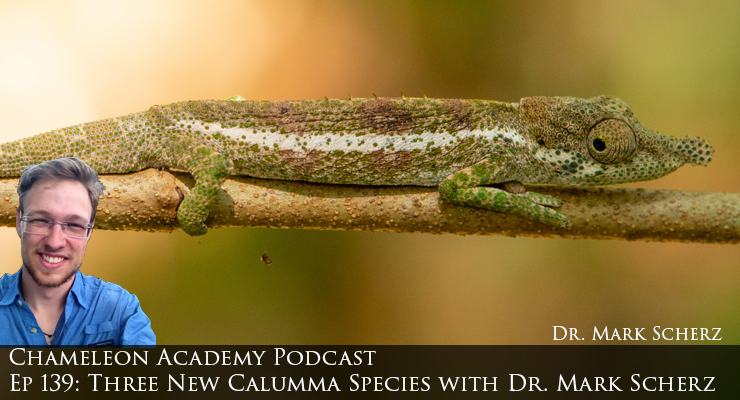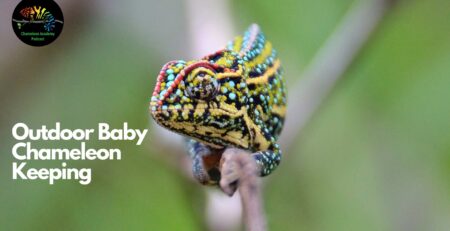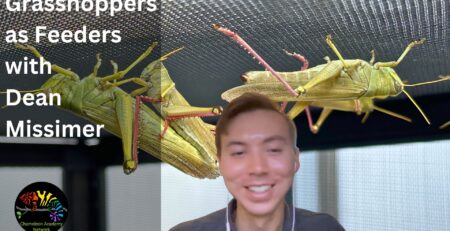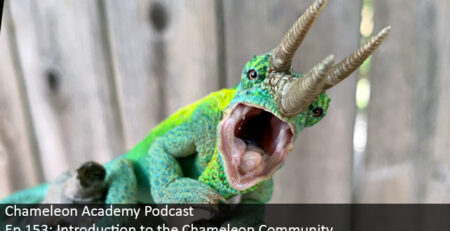S7 E2 Caring for Egg-Laying Female Chameleons
Today we are going to talk about the kind of special care a female egg laying chameleon needs.
My name is Bill Strand and my job here is to help you learn the latest in chameleon husbandry techniques and philosophy. Welcome to season seven of the Chameleon Academy Podcast!


Bill Strand
S7 E2: Caring for Egg-Laying Female Chameleons
Transcripts (more or less)
Today we are going to talk about the kind of special care a female egg laying chameleon needs.
My name is Bill Strand and my job here is to help you learn the latest in chameleon husbandry techniques and philosophy. Welcome to season seven of the Chameleon Academy Podcast!
I always say to buy captive bred chameleons because the baby was taken care of a year before its egg was even laid. Because the health of the mother is a huge factor in the health quality of the baby chameleon you raise up.
So let’s jump into the topic of caring for female chameleons of egg laying species. I did an episode last season about Jackson’s Chameleons and other live bearers so today I am going to skew the discussion towards egg layers. But, since Live bearing chameleons are simply chameleons that keep their eggs inside of them until they are ready to hatch, there are many parallels.
Now, I know I am creating a whole show around this, but I have to let you know that the care of a gravid female is not much different from the care of a male. The captive husbandry conditions are the same for males and females. The difference is that the consequences of the females not having ideal conditions are much more severe if your throw in the stress of developing eggs. And so it is absolutely worth us stepping back and checking all the parameters if we intend on breeding. Because you could be sliding by with some compromises and not noticing an issue and thinking all is well. But when you heap on the added strain of creating 30 more lives within the female’s body you may find things crashing around you. So, it is well worth a re-evaluation of conditions to stack the odds in your -and her – favor.
And, I think I’d like to repeat this last concept with a little more discussion. It is common for people to judge the quality of their husbandry by whether their chameleon is alive or not. How many times do we see someone cohabitating their chameleons and, when called on it, respond with “they have been this way for three months and are doing fine”. Experienced keepers know that the chameleons are definitely still breathing, but the stress levels are reducing the health margin. Which means when something else comes along, like a cut in the mouth from chomping a cricket leg wrong, they don’t have the health savings to fight the infection. Yes, they officially died from bacterial infection, but you can see the problem with ignoring the issues with the living conditions that brought the chameleon to the point of not being able to fight that infection. And, this is a round about way of saying that if your female is adding on the stress of producing and carrying eggs, it is wise to double down on your husbandry analysis and remove any forms of stress she is currently living with. These can include things as simple as just seeing the male.
Infertile Clutches
So let’s start off long before you are thinking about breeding your female. In fact, maybe you don’t have a male and never want to breed your female! You still need to be aware that her body thinks its only purpose is to reproduce before she gets eaten. I am sorry to tarnish your Disneyesque view of the world, but from a survival standpoint, males are only useful until they mate with a female. Females have a month more use as they gestate the eggs. Once the eggs are laid they have done the minimum and now are expendable. If they mate again and/or more eggs are laid before they become hawk lunch then bonus. Nature is not a nice place. Of course, we do not see it this way! Each chameleon is precious to us and we want them to live as long as possible! But their bodies do not know this. And so, female chameleons may develop eggs even without a male around. This can be quite a surprise to the new keeper!
Now, most species of chameleons are not prone to doing this. We see this most commonly in the Veiled Chameleon and occasionally in the panther or other species. But, by far, this is mostly a Veiled chameleon problem. The reason is that Veiled Chameleons are tanks. They can take temperatures way outside their preferred range both on the high end and low end. And they can take an amazing amount of poor conditions. I am in no way advocating getting a veiled chameleon so you can cut corners, but I am sharing this so you understand that just because your veiled chameleon is living and breathing it doesn’t mean it is healthy or the conditions are good. And the hardiness of the veiled chameleon has deceived the chameleon community into the trap of giving incorrect husbandry to Veiled Chameleons. This isn’t a podcast episode on Veiled Chameleons, but since we have an epidemic of females getting egg bound it is worth talking about it. Veiled chameleons do not live in arid deserts. They live in mountain valleys that become oasises in the rainy season when the veiled chameleon eggs hatch. They grow at breakneck speeds to be able to mate and lay eggs before the dry season comes and kills them. And during the dry season it is easy to photograph them and post pictures of veiled chameleons on dead twigs. The fact is that Veiled Chameleons are montane chameleons and live at altitudes above the common Yellow-Crested Jackson’s Chameleon. Let that sink in, Veiled Chameleons should be kept more closely to Jackson’s Chameleon conditions. The reason why we have had it wrong for so long is that keeping veiled chameleons in hotter conditions produced supercharged bodies which had huge clutches of eggs. And that, in our human minds, is a sign of success. In reality, that is just their bodies reacting to the incorrect husbandry. So why don’t Jackson’s Chameleons have this problem? Well, they don’t have this problem because if they are kept too hot they just die. So, we learned not to do that. I know this rubs many people the wrong way, but I ask, if females routinely die egg bound and some vets are now proactively suggesting spaying the chameleons to save their lives and these poor females are so bloated they cannot hang onto branches properly…doesn’t that suggest to you that something is wrong? Some breeders have taken the plunge and have kept their Veiled like Jackson’s and have found that the number of eggs produced is drastically reduced and infertile clutches are the exception instead of the rule.
The problem we will run into making this sweeping change across the community is that this is relatively new and it will take some time for it to spread. But, this is an important place to start this conversation because infertile clutches can happen to people who have no intention of breeding. So, we will get this scenario out of the way before getting into preparing for breeding.
Infertile clutches are usually brought on by female chameleons too warm and fed excessively. Especially Veiled Chameleon female bodies respond to these conditions by doing an egg laying cycle. The problem is that the excess of food and heat has supercharged the body and a veiled chameleon female can easily produce 60 to over 100 egg clutches. And this is life threatening. The excessive food that is giving the body the signals to over produce is also swelling up the fat pads that will choke off the oviducts and prevent eggs from exiting the body. You see the issue here. Dystocia is the word for the many things that can cause egg binding – or the inability to lay eggs. And obesity is just one of the things that can cause this condition.
The way to prevent over production of eggs is to 1) lower the basking temperature. The breeders who have been working with this method have used the low 80s for basking and 70s for ambient 2) nighttime drop into the 60s and 3) reduce feeding to three feeders every other day. If you need more than a podcast guy to change your mind then just look at the environmental conditions for Ibb, Yemen from April to September. That is what you are trying to recreate. Take a look at elevation while you are there and compare that to the elevation of Chogoria, Kenya where our xantholophus Jackson’s Chameleons are from. And you can start to put together a story that makes sense for yourself.
Now, what happens when you do have a female that has a huge clutch of eggs she is trying to pass. It doesn’t matter if it is fertile or infertile. You have a female who has massive stress on her body as she is carrying a clutch of eggs two to three times what she was designed to do. Option 1 is to have a vet spay her and remove the oviducts and eggs. If she is so huge she cannot move correctly then you have to judge whether she will be able to dig and lay her eggs. Unfortunately, there is no way to tell this ahead of time. And if you wait until she is in distress from not being able to lay the eggs the chances of her surviving drops because her body is exhausted and weakened. Option 2 is to let her go through the egg laying and hope it is successful. This is the most preferable way. Veiled chameleon females have successfully laid 60 to 100 egg clutches. So there is a chance it could work. The problem is that if there is distress, something like Oxytocin, which is given to induce labor, is useless if there is a physical reason for the problem. If you choose option 2 then all you can do is keep her in optimal conditions and hope her body does the job. Afterwards you can work on clutch reduction techniques.
Nutrition
Nutrition is always important Best practices are a wide variety of gutloaded feeders with a supplementation routine specific for that species. And here is where you check the care summary for the species you have. Some species, like Jackson’s and quadricornis, are more sensitive to the powders we use and so be careful to do what a reputable care sheet tells you. While producing eggs the nutrition you give her now will determine the babies you get later. She has the gestation time, which is one month for common species like panther and veileds, to give all the required vitamins to each of the eggs she produces. You don’t have to change the way you supplement her while gravid if you are starting off with a solid supplementation regimen. I am careful not to mention a regimen because different species need different regimens.
And here is where a solid UVB light is necessary. That is part of the nutrition consideration. When the female is calcifying 30 eggs, any deficiency in your calcium or UVB husbandry will get a spotlight.
Feeding Schedule
Generally speaking, the standard feeding schedule is to feed babies as much as they can eat every day tapering off to two to three feeders every other day for adults. Gravid females, though, go back to eating as much as they want. By feeding females the three feeders every other day before they mate the body is not in excess mode. The feeding conditions are taken into account when the body decides how many egg follicles to activate. If the times are good it thinks it should make more babies. If the female is in the standard maintenance mode we are talking about, those three feeders every other day, then the body will not want to produce an obnoxiously high number of eggs. Now here is the rub. We are used to seeing very rounded chameleon bodies as healthy. If you are trying to reset your view of how they should look they take a look at any pictures of wild chameleons. That is your health baseline. And it is very important that you develop this health baseline. You can start out judging feeder quantity from a care sheet, but as soon as possible, you need to be able to make those judgements yourself based on how your chameleon is doing. Remember that care sheets are the starting point. They cannot account for every nuance. You need to observe your chameleon’s behavior and see if any parameter needs to be adjusted.
Lay Bin
Fertile or not, if your female is going to lay eggs you need to provide a lay bin of soil. Here is where the community is holding on to some old ideas that need to evolve. Generally speaking, we fill the lay bin with a 50/50 sand/soil mixture. Though, to be honest, I often just scoop up a bunch of dirt. And it works just fine. The key is the depth. For chameleons like veiled or panther the depth doesn’t need to be more than four inches or 10 cm deep. In fact, giving more than that will just wear out your female as she digs and digs trying to find the hard surface to lay against. The advice to have 12” deep laybins comes from misinterpreting the behavior of females digging to the bottom of buckets. They were looking for the hard surface of the bottom of the bucket and the well meaning keepers interpreted that as that the females wanted to tunnel into the earth to lay their eggs. Nope. How many years have people forced the poor female to dig through a foot deep of soil risking tunnel collapse to lay their eggs? Here is a bonus, if you just give four inches then you don’t have to worry so much about whether it is structurally sound when the female digs a hole in it. You simply don’t have to worry about collapse. Once again, if you run into people who are adamant about a deep laying bin you just let them insist. You just go Google images of wild chameleons laying eggs and notice that they generally have their head above the dirt and you go ahead and estimate how deep their body, at an angle, really is. It was eye opening when I gave my female chameleons a 20×20 egg laying corral with perfect dirt and saw how they always picked the imperfect dirt and never laid their eggs deep. Hmmm…what do to with the information I thought I knew? Remember, these babies need to be able to tunnel back out. So, there’s the data. You can make your decision. I literally just use a 4” plastic box with dirt in it so anything fancy you do will be better.
Once you have the laying bin in place give her privacy during the egg laying process. I know we want to keep checking on her. And people like me want to document everything. Well, laying eggs is an extremely vulnerable time for a chameleon so forgive her for being extra vigilant to find a safe place to lay. Make it easy on her and block off the side and front of the cage with tiny holes for you to stealthfully look through.
Once the eggs are laid you treat that lady like the queen she is. Food, water, and privacy! After a week or two of eating as much as she wants it is a good idea to tapper off to the maintenance diet as her. Body may soon consider going for a second clutch with retained sperm. And, yes, that is common so be ready for it. It doesn’t happen all the time, but it happens enough that it is a surprise when it doesn’t happen.
Now, through all of this I hope I have been able to instill in you a deep respect and value for what reputable breeders go. And how valuable a captive hatched baby is. It is many, many months of care for the female that produces that healthy baby. And it is worth it. Be grateful that we have the breeders that we do. Yes, they think they are living the dream, but how awesome is it that we can go shopping for whatever color panther chameleon we decide we like? I think we live in a very cool chapter of the history of the chameleon community.
Thank you so much for joining me here. If you are interested in learning about the other life I live, you can go check out the first episode of season 2 of the Exotic Pet Collective podcast and on YouTube. Richard Stewart interview me and we talked about my other show, the Reptile Entrepreneur podcast where I talk about how to set up a business in the reptile community. If you want to be a breeder, or influencer, or make products, that is a great podcast for you. And you can get a little behind the scenes talk by listen to this interview.
So, I think it is time we go into the world and enjoy the fact that we commune with mini tree dragons. It’s a good life!

